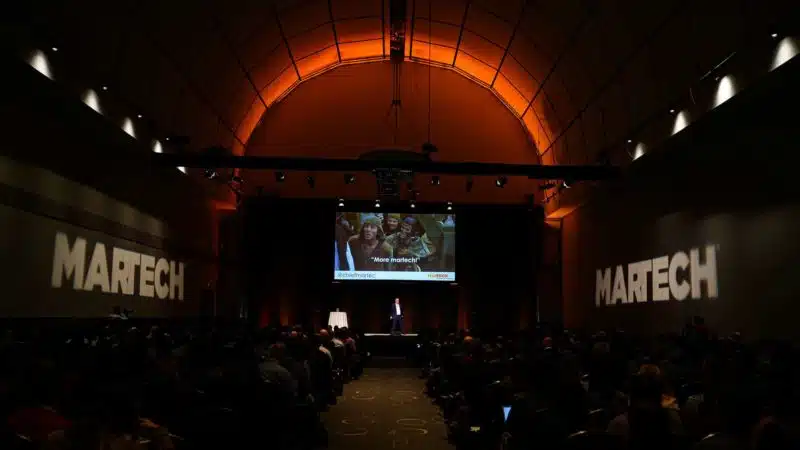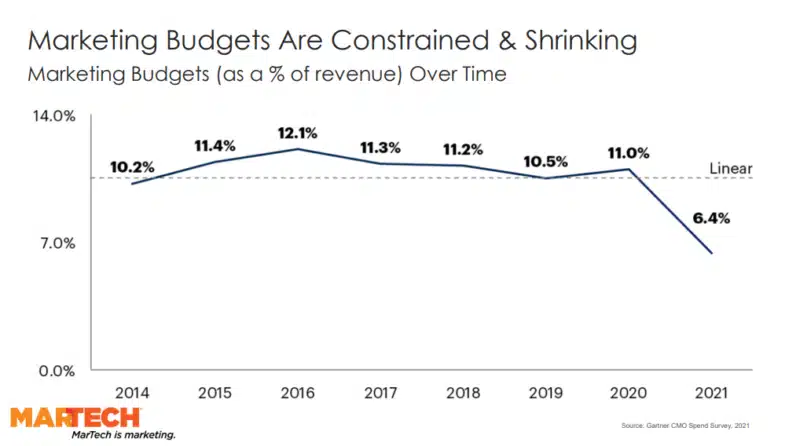Making the case for marketing technology within your organization
Having an always-on system is a marketer’s goal. Here’s how to get your business on board.
It’s up to marketers to make the case for the technology they want to use. More than they might think, marketers hold the future of their organization’s digital transformation in their own hands. This was the message from Michael McCune, Senior Director at Gartner, at our recent MarTech conference.
“Every marketing leader wants to break free of the constraints to their transformation, and often these constraints are portrayed as obstacles that others put in marketing’s way,” said McCune. “But it’s actually marketing that presents the biggest obstacle to its own transformation ambitions.”
That’s because marketers fail to define a goal or “end state” for the technology they want to implement, according to McCune. They also need to enable continuous improvements towards that end state, and they need to obtain persistent funding to execute those changes, over time.
Always-on marketing
With marketing automation tools and omnichannel campaign execution, marketers seek a way to scale their functions and, ultimately, increase ROI by running an efficient team that is using the latest technology.
The end goal McCune described is an “always-on” set of functions that operate 24/7, like a machine.
“Managing and maintaining that always-on marketing machine will feel much more like owning a manufacturing line than, say, leveraging your in-house agency,” he said.
This might sound ideal for marketers. But in order to acquire the tools to make this a reality, they need to build a case and a roadmap for their organization.

Making the case for funds
First, marketers need to make the financial case. This has become an even greater challenge due to pandemic belt-tightening across industries. But the difficulties in making this case go further back.
“There’s a lot more competition for investment in transformation across the enterprise,” said McCune. “Over the last half decade, marketing has tried to fund transformation with flat budgets, and that’s made it difficult for marketing to obtain and retain funding for transformation.”

He added, “In the past year, making the case for marketing transformation investment has gotten markedly harder as budgets have shrunk dramatically.”
Competition can also come from within the org. When businesses are evaluating how to fund digital transformation, they often try to spread this across not just marketing but sales, service and digital commerce functions as well.
“In response to this scrutiny and competition, marketing can’t just talk about its future aspirations,” McCune said. “It has to improve its business case.”
Dig deeper: Real Story on MarTech: The new stack
Impacting CLV
The best way for marketers to guard themselves against incremental funding fights is to reframe the debate around success.
“Success is found when a leader re-anchors their discussions on a more assertive claim about how new capabilities will enable them to impact customer lifetime value,” said McCune. “It’s a financial promise about the impact that those aspirational capabilities will enable.”
He added, “Instead of having discussions about technology, marketing leaders should talk about the capabilities they want to bring to the marketing organization — the same ones that are commonly asserted, but now tied to a very real business outcome against which progress can be measured.”
Organization
McCune also advocated for a centralized organization of people and processes to ensure the success of the new technology.
“The entire purpose behind this centralization effort is not to retake control of the front line,” McCune stated. “It is specifically to put in place a way to manage people, processes, data and technology that enables organizations to sense and respond quickly without degradation of messaging or brand relevance.”
Centralized communication around new marketing technology allows for more robust testing and experimentation. If something new works in one part of the organization, it can be replicated in other places.
“However, these structural dynamics are an important element of enabling transformation, they don’t do all the change,” McCune said. “This is why we’ve seen the rise of the marketing operations function.”
Marketing operations
“Marketing operations is absolutely an essential investment to see through transformation and to enable your continuous improvement,” said McCune. “But the path blazed by the first movers hasn’t always been the right path to follow.”
He added, “Marketing operations is an investment in change management, one that absolutely does facilitate transformation.”
The problem organizations run into is when they view marketing ops as just a subfunction inside marketing. Instead, marketing operations needs to be staffed by committed full-time professionals.
Digital transformation is ultimately as dependent on the people and strategy that execute it as on the technology itself.
Watch the full presentation from our MarTech conference here (free registration required).
Contributing authors are invited to create content for MarTech and are chosen for their expertise and contribution to the martech community. Our contributors work under the oversight of the editorial staff and contributions are checked for quality and relevance to our readers. MarTech is owned by Semrush. Contributor was not asked to make any direct or indirect mentions of Semrush. The opinions they express are their own.
Related stories
New on MarTech